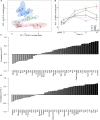Cold Acclimation Favors Metabolic Stability in Drosophila suzukii
- PMID: 30443218
- PMCID: PMC6221910
- DOI: 10.3389/fphys.2018.01506
Cold Acclimation Favors Metabolic Stability in Drosophila suzukii
Abstract
The invasive fruit fly pest, Drosophila suzukii, is a chill susceptible species, yet it is capable of overwintering in rather cold climates, such as North America and North Europe, probably thanks to a high cold tolerance plasticity. Little is known about the mechanisms underlying cold tolerance acquisition in D. suzukii. In this study, we compared the effect of different forms of cold acclimation (at juvenile or at adult stage) on subsequent cold tolerance. Combining developmental and adult cold acclimation resulted in a particularly high expression of cold tolerance. As found in other species, we expected that cold-acclimated flies would accumulate cryoprotectants and would be able to maintain metabolic homeostasis following cold stress. We used quantitative target GC-MS profiling to explore metabolic changes in four different phenotypes: control, cold acclimated during development or at adult stage or during both phases. We also performed a time-series GC-MS analysis to monitor metabolic homeostasis status during stress and recovery. The different thermal treatments resulted in highly distinct metabolic phenotypes. Flies submitted to both developmental and adult acclimation were characterized by accumulation of cryoprotectants (carbohydrates and amino acids), although concentrations changes remained of low magnitude. After cold shock, non-acclimated chill-susceptible phenotype displayed a symptomatic loss of metabolic homeostasis, correlated with erratic changes in the amino acids pool. On the other hand, the most cold-tolerant phenotype was able to maintain metabolic homeostasis after cold stress. These results indicate that cold tolerance acquisition of D. suzukii depends on physiological strategies similar to other drosophilids: moderate changes in cryoprotective substances and metabolic robustness. In addition, the results add to the body of evidence supporting that mechanisms underlying the different forms of acclimation are distinct.
Keywords: cold shock; cold tolerance; homeostasis; metabolites; metabotype; recovery; spotted wing drosophila.
Figures






References
-
- Angilletta M. J. (2009). Thermal Adaptation. A Theoretical and Empirical Synthesis. Oxford: Oxford University Press; 10.1093/acprof:oso/9780198570875.001.1 - DOI
-
- Arnó J., Solà M., Riudavets J., Gabarra R. (2016). Population dynamics, non-crop hosts, and fruit susceptibility of Drosophila suzukii in Northeast Spain. J. Pest Sci. 89 713–723. 10.1007/s10340-016-0774-3 - DOI
-
- Asplen M. K., Anfora G., Biondi A., Choi D. S., Chu D., Daane K. M., et al. (2015). Invasion biology of spotted wing Drosophila (Drosophila suzukii): a global perspective and future priorities. J. Pest Sci. 88 469–494. 10.1007/s10340-015-0681-z - DOI
Grants and funding
LinkOut - more resources
Full Text Sources
Molecular Biology Databases
Research Materials
Miscellaneous

